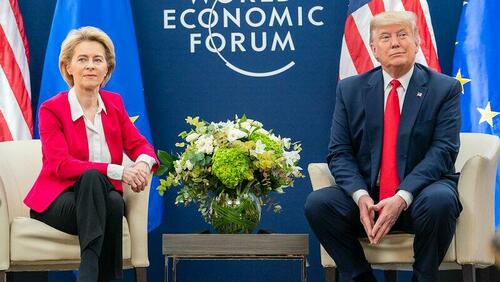By Michael Every of Rabobank
Flash Rally
If there exists something like a flash crash, then should we call yesterday’s move a flash rally? About an hour after the opening bell, in a matter of seven minutes, the S&P 500 moved from a 2.3% loss on the day to a 3% gain. Bloomberg calculated that the rumor that Trump was considering to delay his country-specific tariffs by 90 days added $2.5 trillion back to equity valuations, but most of those gains were quickly lost again when the president denied the story as being “fake news.”
Although that reversed the rally, interestingly, the selling spree did not resume. The S&P 500 fluctuated between a 5,000 and 5,100 band for the remainder of the trading day. Was this a well-placed intervention to try and stop the bleeding, or was it pure coincidence? It certainly gave rise to new hope that a large enough decline in stocks would force Trump to reconsider.
Even Trump’s threat to impose an additional 50% tariff on China, in response to their retaliation, did not really dent US markets much. Nor did his threat to cancel all scheduled talks with Beijing until the Chinese government lifts its retaliatory tariffs. Perhaps that’s because President Trump added that he remains open to “fair deals” with every country, and that negotiations with those countries that have requested meetings will begin immediately.
Treasury Secretary Bessent announced that over 70 countries have approached the US to negotiate. But does the US have the capacity to negotiate all of these at once? There will probably be a queue of countries waiting for their chance to discuss a trade deal. So it’s a case of first-come, first-serve.
Japan, being one of the first to reach out to the US, is expected to get priority in the trade talks. But that doesn’t mean a deal will quickly be reached. Even though Japan has already offered concessions, Trump denounced the Japanese non-tariff barriers on agricultural products.
Where does that leave Europe? The bloc’s trade ministers were still discussing their response yesterday – both potential countermeasures they can implement, as well as the deals they could offer Trump. So, the EU is probably not the first in the negotiating line after Japan. Moreover, Trump is vehemently opposed to the EU’s non-tariff barriers as well. And if the EU decides to implement rebalancing measures while it awaits any deal, what’s the risk that Trump cuts them off, just like he did China?
Moreover, Trump’s talks with Netanyahu should be worrying for EU diplomats hoping to strike a deal. The Israeli president was the first to fly to the US after Trump announced his sweeping tariffs. He told Trump that the Israeli government is willing to work with the US to quickly reduce the trade deficit. Yet, even though the trade deficit forms the foundation of the formula for countries’ individual tariff rates, the US president reacted less enthusiastic than one might have expected. “Maybe not, don’t forget, we help keep Israel alive,” Trump told reporters, adding that the US gives “billions of dollars a year” in defence. Again, where does that leave Europe?
Indeed, Trump’s stance towards Israel resonates with the longer held views of Stephen Miran, the Chair of Trump’s Council of Economic Advisers. Yesterday, Miran reiterated these. He spoke on the “global public goods” that the US provides the world: a security umbrella, and the global reserve currency. He continued that Trump will not stand for other countries’ free-riding, suggesting some solutions along the lines he mentioned before. Summarizing his ideas, Miran essentially suggests that countries can either accept tariffs without retaliation; open their markets more to US exporters; boost defense spending and procurement from the US; invest in US factories; or they could simply write checks to the Treasury that help the US finance these global public goods.
Against those comments, it’s hard to see how the EU can strike a deal, without writing that check. The EU has expressed willingness to drop tariffs on industrial goods and cars, provided that the US does the same. But will that even be close to sufficient to convince Trump to lower his tariffs against the EU? Trump also hinted in another direction again, noting that Europe would have to “buy more energy from us.”
So, Europe perhaps best dig in for protracted negotiations. That may involve partial rebalancing measures, but the bloc will probably stop well short of full retaliation – to let Trump’s ire focus on China. Indeed, that could well be another potential angle for Europe: the US may be more sensitive to EU measures that show the bloc is willing to take a tougher stance against China.
That may even allow the EU to kill two birds with one stone: Measures to support the domestic industry are probably more pressing. Those policies will predominantly take the form of anti-dumping measures. To ensure that the EU can detect the redirection of third countries’ exports quickly, the European Commission has launched an “import task force” that will monitor trade flows against historical patterns. This should reduce the response time if any anti-dumping measures are needed.
Outright fiscal support to those sectors that are hardest hit by the US tariffs may be another element of the EU’s response. Spain is not waiting for European consensus on that matter, though. Prime Minister Sanchez has unveiled a €14 billion support package for Spanish companies. Half will be used to provide cheap loans to companies affected by the levies, €400 million is earmarked for the automotive industry, and the remainder will go towards modernizing Spain’s industry. However, one would hope that Europe also unites on this front.
Loading…


















